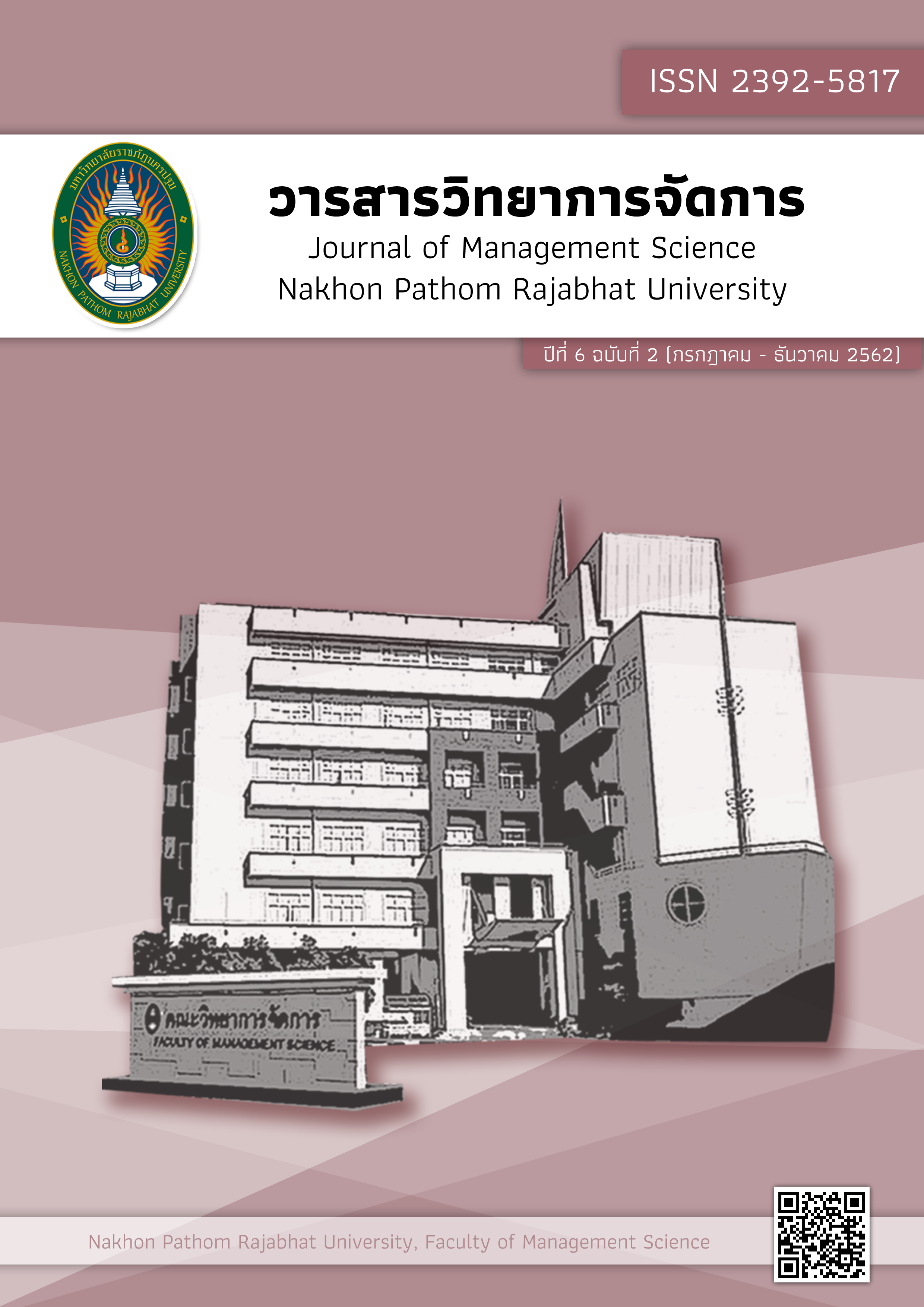Guidelines for leadership application for Buddhist temple administration and development in Nakhon Pathom Province
Main Article Content
Abstract
This research aimed to: 1) compare the development level of Buddhist temples in Nakhon Pathom Province classified by personal factors; 2) study the influence of leadership affecting the development level of Buddhist temples; and 3) find the guidelines to develop leadership for administration to develop Buddhist temples in Nakhon Pathom Province. Mixed method research design was used in this study. Regarding quantitative research, the sample of 250 abbots or those equivalent in positions was derived by stratified sampling. The research instrument was a questionnaire constructed by the researcher with the content validity between 0.67- 1.00 and the reliability coefficients between 0.75- 0.95. Data were analyzed with mean, standard deviation, t-test, one-way ANOVA, least significant difference, and multiple regression analysis. As for qualitative research, 6 key informants were derived by purposive sampling. They were administrators and administrative committee who set administrative policy of Buddhist temples in Nakhon Pathom Province. The instrument was an interview form constructed by the researcher and data were analyzed by content analysis.
1. Regarding the comparison of temple development in Nakhon Pathom Province as classified by personal factors, it was found the difference with statistical significance level at .05 among those who differed in years of ordination and Buddhist education.
2. Regarding the influence of leadership, it was found that the aspects of vision (β = 0.22), and faith (β = 0.37) together predicted the development level of temples in Nakhon Pathom Province at the percentage of 43. The regression equation was Y = 0.06X1 + 0.26X2** + 0.04X3 + 0.38X4** + 0.10X5.
3. The guideline for enhancing the leadership for administration to develop temples in Nakhon Pathom Province should be start from personal development in mental aspect. The abbots should focus on personnel’s willing, diligence, intention and intelligence in development. According to criteria of National Office of Buddhism, the framework of temple jurisdiction comprised 6 aspects: administration, propagation, public facility, education, public welfare, and education welfare. Those who administered the temples should have appropriate seniority and qualification. To efficiently administer the temples, administrators should have knowledge, capability, and experiences. They also should make sensible decision, have administrative skills to develop the temples, make benefits for stakeholders, and continually propagate Buddhist teaching.
Article history : Received 18 July 2017
Revised 7 January 2019
Accepted 15 January 2019
SIMILARITY INDEX = 6.19
Article Details
The views and opinions of the article appearing in this journal are those of the author. It is not considered a view and responsibility of the editorial staff.
References
เฉียบ ไทยยิ่ง. (2541). รายงานการวิจัยเรื่อง ปัจจัยที่ส่งผลต่อความสําเร็จของเจ้าอาวาสในการพัฒนาวัดให้เป็นศูนย์กลางของชุมชน กรณีศึกษา: ภาคเหนือและภาคตะวันออกเฉียงเหนือ. กรุงเทพฯ: กรมการศาสนา.
ธีรวุฒิ ทองโอษฐ์. (2544). การศึกษาการปฏิบัติศาสนกิจของเจ้าอาวาสในจังหวัดร้อยเอ็ด.วิทยานิพนธ์การศึกษาศาสตรมหาบัณฑิต สาขาวิชาการบริหารการศึกษา บัณฑิตวิทยาลัย มหาวิทยาลัยศรีนครินทรวิโรฒ.
บุญช่วย จันทร์เฮ้า. (2544). พฤติกรรมการบริหารของเจ้าอาวาสที่ส่งผลต่อการปฏิบัติงานวัดในเขตการปกครอง คณะสงฆ์จังหวัดกรุงเทพมหานคร. วิทยานิพนธ์ศึกษาศาสตรมหาบัณฑิต สาขาวิชาการบริหารการศึกษา ภาควิชาการบริหารการศึกษา บัณฑิตวิทยาลัย มหาวิทยาลัยศิลปากร.
พระทีฆทัสสีมุนีวงศ์ (วิรัช วสสิริ) จำนงค์ อดิวัฒนสิทธิ์ สอาด บรรเจิดฤทธิ์ และบุญเรือง ศรีเหรัญ. (2558).ตัวแบบการบริหารคณะสงฆ์ในเขตปกครองคณะสงฆ์ภาค 4. วารสารบัณฑิตศึกษา มหาวิทยาลัยราชภัฏวไลยอลงกรณ์ ในพระบรมราชูปถัมภ์. 9 (1).81-95.
พระธนดล นาคสุวณฺโณ (นาคพิพัฒน์). (2551). การบริหารกิจการคณะสงฆ์จังหวัดบุรีรัมย์. วิทยานิพนธ์พุทธศาสตรมหาบัณฑิต สาขาวิชารัฐประศาสนศาสตร์ บัณฑิตวิทยาลัย มหาวิทยาลัย มหาจุฬาลงกรณราชวิทยาลัย.
พระมหากฤษฎา นันทเพชร.(2540). ทัศนคติของพระสงฆ์ต่อบทบาทการพัฒนาสังคม. วิทยานิพนธ์พัฒนบริหารศาสตรมหาบัณฑิต สาขาวิชาพัฒนาสังคม บัณฑิตวิทยาลัย สถาบันบัณฑิตพัฒนบริหารศาสตร์.
พระมหาสมพงษ์ เกษานุช ภักดี โพธิ์สิงห์ และยุภาพร ยุภา. (2561).รูปแบบพัฒนาการจัดการศึกษาพระปริยัติธรรมแผนกธรรมและแผนกบาลีของสำนักศาสนศึกษาในเขตปกครองคณะสงฆ์ภาค 8 .วารสารวิชาการธรรมทรรศน์. 18 (1).1-12.
พระมหาสุริยา หอมวัน. (2544) บุคลิกภาพของเจ้าอาวาสที่พึ่งประสงค์: กรณีศึกษาพระสงฆ์สามเณร วัดสระกําแพงใหญ่อําเภออุทุมพรพิสัยจังหวัดศรีสะเกษ. สารนิพนธ์ศิลปศาสตมหาบัณฑิต สาขาวิชาการบริหารองค์การ บัณฑิตวิทยาลัย มหาวิทยาลัยเกริก.
พระมหาอนุศักดิ์ จันทราลักษณ์. (2554). ปัญหาและแนวทางแก้ปัญหาการบริหารจัดการวัดของเจ้าอาวาสในเขตจังหวัดมหาสารคาม. วิทยานิพนธ์มหาบัณฑิต .บัณฑิตวิทยาลัย มหาวิทยาลัยมหาสารคาม.
พระอกนิษฐ์ สิริปญฺโญ (อาจวิชัย). (2555). การบริหารจัดการด้านสาธารณูปการของพระสังฆาธิการในอำเภอเมือง จังหวัดปทุมธานี พุทธศาสตรมหาบัณฑิต (การจัดการเชิงพุทธ). กรุงเทพฯ: มหาวิทยาลัยมหาจฬุาลงกรณราชวิทยาลัย.
พระอำนวย หมอกเมฆ สราญภัทร สถิรางกูร สุชาติ ตันธนะเดชา และธเนศ จิตสุทธิภากร. (2556).กลยุทธ์การบริหารวัดในพระพุทธศาสนาสำหรับเจ้าอาวาสวัดราษฎร์ในเขตหนเหนือ ภาค 4. สักทอง : วารสารมนุษยศาสตร์และสังคมศาสตร์. 19 (1). 73-89.
วัชรี บูรณสิงห์. (2543). การบริหารหลักสูตร (พิมพ์ครั้งที่ 2). กรุงเทพฯ: มหาวิทยาลัยรามคำแหง
วิโรจน์ สารรัตนะ. (2553). ผู้บริหารโรงเรียนสามมิติการพัฒนาวิชาชีพสู่ความเป็นผู้นำที่มีประสิทธิผล.(พิมพ์ครั้งที่ 7). ขอนแก่น: คลังนานาวิทยา.
ศักดิ์ชัย ภู่เจริญ. (2552). ความหมายของภาวะผู้นำ. [ออนไลน์]. ค้นเมื่อ 2 สิงหาคม 2559 จาก https://www.kruinter.com/show.php?id_quiz=988&p=1
สำนักงานจังหวัดนครปฐม. (2558). สถิติพระจำพรรษาของสำนักงานเจ้าคณะจังหวัดนครปฐม. [ออนไลน์]. ค้นเมื่อ 19 พฤษภาคม 2558, จาก https://www.nakhonpathom.go.th/content/History
เสนาะ ติเยาว์. (2549). หลักการบริหาร. (พิมพ์ครั้งที่ 3). กรุงเทพฯ: มหาวิทยาลัยธรรมศาสตร์.สำนักงานพระพุทธศาสนาแห่งชาติ. (2554). คู่มือการพัฒนาวัดสู่ความเป็นมาตรฐาน. [ออนไลน์]. ค้นเมื่อ 22 สิงหาคม 2559 จาก https://www1.onab.go.th/e-Books/WadStandard.pdf
Blanchard, O. (2006). Macroeconomics. (4th ed.). New Delhi: Pearson Education Asia.
Cronbach, L. J. (1970). Essentials of psychological testing (3rd ed.). New York: Harper & Row Publishers.
Fukuyama, F. (1995). Trust: the social virtues and the creation of prosperity. New York : Free Press.
Johnson, L. H., Dahlen, R. & Robert, S. L. (1997). Supporting hope in congestive heart failure patients. Dimension of Critical Care Nursing, 16 (2), 65-78.
Klenke, K. (2003). The “s” factor in leadership education, practice, and research. Journal of education for business, 4 (7), 56-60
Komives, S. R., Lucas, N., & McMahon, T. R. (1998). Exploring Leadership for College Students Who Want to Make a Difference. San Francisco. CA: Jossey-Bass.
Kriger, M., & Seng, Y. (2005). Leadership with inner meaning: a contingency theory of leadership based on the worldviews of five religions. The leadership quarterly, 16 (5), 771-806.

